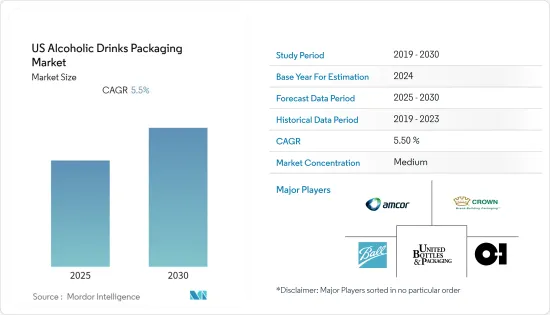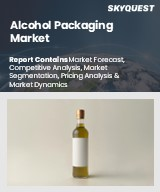
|
시장보고서
상품코드
1640531
미국의 알코올 음료 포장 : 시장 점유율 분석, 산업 동향, 성장 예측(2025-2030년)US Alcoholic Drinks Packaging - Market Share Analysis, Industry Trends & Statistics, Growth Forecasts (2025 - 2030) |
||||||
■ 보고서에 따라 최신 정보로 업데이트하여 보내드립니다. 배송일정은 문의해 주시기 바랍니다.
미국의 알코올 음료 포장 시장은 예측 기간 동안 CAGR 5.5%를 기록할 전망입니다.

주요 하이라이트
- 시장 성장은 알코올 소비 증가, 크래프트 맥주 산업에서 금속캔 수요 증가, 알코올 음료 산업에서 PET 포장 사용 증가 등 다양한 요인에 의존하고 있습니다.
- 알코올 음료의 포장은 디자인, 견고성, 테이크아웃 측면에서 크게 진화하고 있습니다. 알코올 음료 제조업체는 브랜드를 표현하고 이산화탄소 배출량을 줄이며 테이크아웃에 적합한 용기를 제공하는 혁신적인 방법을 모색하고 있습니다.
- 또한, 알코올 음료 생산자는 정기적으로 신제품과 새로운 맛을 발표하여 소비량을 늘리고 알코올 음료 포장 시장을 뒷받침하고 있습니다.
- 조사 지역의 알코올 음료 포장 시장 성장은 에너지 및 원재료 비용 상승으로 크게 저해되고 포장 제조 비용이 상승하고 있습니다.
- COVID-19가 발생하는 동안 바이러스의 영향을 억제하기 위한 조치로 공급망 프로세스가 영향을 받고 여러 국가에서 생산 공장을 폐쇄하며 다양한 국가에 의해 시행된 봉쇄 조치로 인해 조사된 시장은 저성장에 직면하고 있습니다.
미국 알코올 음료 포장 시장 동향
플라스틱이 성장을 견인
- 알코올 음료는 플라스틱 포장 솔루션을 채택하는 경향이 커지고 있습니다. 다양한 음료 포장용 스탠드업 파우치와 스파우트 파우치에 대한 수요가 증가하고 있습니다. 그러나 음료의 품질은 pH, 저장 온도, 압력, 오염 물질의 존재에 영향을 받습니다. 고도 변화는 음료의 조성을 변화시킬 수 있습니다. 산화 가능성을 배제하기 위해 높은 장벽성(열, 습기, 박테리아) 등의 특성을 가진 연질 포장 제품을 채용하는 기업이 늘고 있습니다.
- 생산, 선적, 재료 취급 비용 절감 추세와 함께 포장 재료의 경량화가 빠르게 채택되는 경향이 음료의 연질 플라스틱 포장을 뒷받침하고 있습니다.
- 음료용 유리 포장의 물류는 운송 중 파손의 발생이 빈번하므로 비싸고 불편합니다. 플라스틱 포장이 제공하는 비용 효과와 물류 용이성은 여러 음료 제조업체에게 플라스틱 포장을 선택하도록 촉구합니다. 이러한 도입의 가능성은 조사 시장에 긍정적인 영향을 미칠 것으로 예상됩니다.
- 음료 포장에 자주 사용되는 스파우트 스탠드업 파우치는 매장에서 보다 효과적이고 효율적으로 세워서 진열할 수 있어 예측 기간 동안 액체 포장에 대한 사용이 증가할 것으로 예상됩니다. 음료 포장에 사용되는 일반 유리 및 경질 플라스틱보다 저렴하기 때문에 스파우트 스탠드업 파우치는 보급될 것으로 예상됩니다.
큰 시장 점유율을 차지할 것으로 예상되는 유리병
- 유리는 재활용 가능하며 품질이나 순도를 떨어뜨리지 않고 무한히 재사용할 수 있으므로 알코올 음료 포장에도 자주 사용됩니다. 유리의 내수성은 유리 포장된 알코올의 풍미 변질을 방지합니다.
- 맥주병 수요 촉진과 함께, 조사 지역 전체에서 주류병과 같은 유리 수요가 증가하고 있는 점은 특히 COVID-19의 대유행에 의한 수요 하락 후의 캔 부족 현상에 기인하고 있습니다.
- 또한 유리병은 휴대용 및 보관에 매우 편리하기 때문에 소비자에게 선호되는 옵션이 되었습니다. 이러한 요인은 알코올 음료용 유리병 포장 수요를 촉진할 것으로 예상됩니다.
- 포장에 재활용 소재를 사용하려는 노력으로 병에 사용하는 재활용 유리의 비율을 높이는 주류 제조업체가 늘고 있습니다. 예를 들어, Absolut는 재활용 유리를 41% 사용한 한정 디자인을 출시함으로써 포장 낭비를 최소화하는 노력을 보여주고 있습니다.
- 재생 유리는 화학적 상호 작용의 비율이 0%이기 때문에 알코올의 강도, 향기 및 풍미에 영향을 주지 않습니다. 그 결과 유리 카테고리는 조사 지역의 알코올 음료 포장 시장 점유율을 확대할 것으로 예상됩니다.
미국 알코올 음료 포장 산업 개요
알코올 음료 포장 솔루션을 제공하는 여러 기업이 있기 때문에 시장 경쟁이 치열해지고 있습니다. 따라서 시장은 적당히 세분화되어 많은 기업들이 확대 전략을 전개하고 있습니다.
- 2022년 5월 - Coca-Cola UNITED Partners는 Oi Glass와 협력하여 새로운 유리병을 만들기 위한 재활용 유리를 확보하고 있습니다. Coca-Cola Bottling Company UNITED는 '쓰레기 없는 세상'을 위해 노력하고 있으며, 2030년까지 병에 50%의 재활용 재료를 사용한다는 목표를 세우고 있습니다.
기타 혜택
- 엑셀 형식 시장 예측(ME) 시트
- 3개월간 애널리스트 지원
목차
제1장 서론
- 조사의 전제조건과 시장 정의
- 조사 범위
제2장 조사 방법
제3장 주요 요약
제4장 시장 인사이트
- 시장 개요
- 산업 밸류체인 분석
- 업계의 매력도 - Porter's Five Forces 분석
- 신규 진입업자의 위협
- 구매자의 협상력
- 공급기업의 협상력
- 대체품의 위협
- 경쟁 기업간 경쟁 관계의 강도
제5장 시장 역학
- 촉진요인
- 소비자의 높은 구매력
- 알코올 음료 소비 증가
- 시장의 과제
- 포장을 둘러싼 환경과 지속 가능성 우려 증가
- 시장에 대한 COVID-19의 영향 평가
제6장 시장 세분화
- 주요 재료별
- 유리
- 금속
- 플라스틱
- 종이
- 알코올 유형별
- 와인
- 증류주
- 맥주
- 레디 투 드링크(RTD)
- 기타 알코올
- 제품 유형별
- 유리병
- 금속캔
- 플라스틱병
- 박스
- 파우치
- 기타 제품 유형
제7장 경쟁 구도
- 기업 프로파일
- Ball Corporation
- Crown Holdings Inc.
- Amcor PLC
- Owens-Illinois Inc.
- United Bottles & Packaging
- Brick Packaging LLC
- Berry Global Inc.
- IntraPac International LLC
- Encore Glass
- WestRock LLC
- Ardagh Group SA
제8장 투자 분석
제9장 시장의 미래
CSM 25.02.20The US Alcoholic Drinks Packaging Market is expected to register a CAGR of 5.5% during the forecast period.

Key Highlights
- The growth of the market depends on serval factors, including the rising consumption of alcohol, the growing demand for metal cans from the craft beer industry, and the increasing use of PET packaging in the alcoholic beverage industry.
- Alcoholic beverage packaging is evolving significantly in terms of design, robustness, and to-go possibilities. Alcohol producers are seeking for innovative ways to represent their brand, reduce carbon emissions, and offer suitable take-out containers.
- Additionally, producers of alcoholic beverages regularly release new products and flavor additions, increasing usage and propelling the market for alcoholic beverage packaging.
- The region's alcoholic beverage packaging market growth is being severely hampered by the growing cost of energy and raw materials, which raises the cost of manufacturing packaging.
- During the outbreak of COVID-19, the market studied faced slow growth due to lockdowns imposed by various countries that have disrupted the supply chain process and the closure of production plants in some countries to curb the effect of the virus.
US Alcoholic Drinks Packaging Market Trends
Plastic to Witness the Growth
- Alcoholic beverages are increasingly embracing plastic packaging solutions. There is an increasing demand for stand-up and spouted pouches for various beverage packaging. However, the quality of beverages is affected by pH, storage temperature, pressure, and the presence of contaminants. Changes in the levels can alter the composition of the beverage. Companies are increasingly employing flexible packaging products with properties such as high barrier resistance (heat, moisture, and bacteria) to eliminate possible oxidation.
- The rapidly adopted tendency of lightweight packaging material, alongside the inclination towards reducing production, shipment, and handling costs, is driving the flexible plastic packaging of beverages.
- Logistics of glass packaging for beverages is expensive and inconvenient due to the large generation of breakage during transportation. Driven cost-effectiveness and ease of logistics offered by plastic packaging have encouraged multiple beverage companies to opt for it. Such likely implementation is expected to impact the studied market positively.
- Spouted stand-up pouches, a product commonly used for beverage packaging, are anticipated to witness an increase in their use for liquid packaging throughout the projection period because they are simple to stand up on store shelves for more effective and efficient display. The market under study is predicted to choose a low-cost option for liquid and beverage packaging, leading to the widespread use of spouted stand-up pouches since they are less expensive than the standard glass and stiff plastic used for beverage packaging.
Glass Bottles Expected to Hold Significant Market Share
- Glass is also often used in alcohol packaging since it is recyclable and may be reused endlessly without losing quality or purity. The water-resistant ability of glass helps avoid contamination of the flavor of alcohol in glass packaging.
- Increased demand for glass, such as liquor bottles, across the region, along with the factor driving the demand for beer bottles, is the shortage of cans, especially after shutdown orders due to the COVID-19 pandemic.
- Glass Bottles also offer great convenience in carrying and storage, making them a preferable choice by consumers. These factors are expected to promote the demand for glass bottle packaging for alcoholic drinks.
- More and more liquor manufacturers are becoming aware of using recycled materials in their packaging and raising the percentage of recycled glass used in their bottles. For instance, Absolut has vowed to minimize packaging waste by launching a limited-edition design made from 41% recycled glass.
- It does not influence the strength, smell, or flavor of the alcohol because it has a 0% rate of chemical interaction. As a result, the glass category is predicted to increase its region's alcohol drinks packaging market share.
US Alcoholic Drinks Packaging Industry Overview
The availability of several players providing packaging solutions for alcoholic beverages has intensified the competition in the market. Therefore, the market is moderately fragmented, with many companies developing expansion strategies.
- May 2022 - Coca-Cola UNITED Partners is partnering with O-I Glass to capture more recycled glass to be created into new glass bottles. Coca-Cola Bottling Company UNITED is committed to building a World Without Waste and has a goal of using 50% recycled material in their bottles by 2030.
Additional Benefits:
- The market estimate (ME) sheet in Excel format
- 3 months of analyst support
TABLE OF CONTENTS
1 INTRODUCTION
- 1.1 Study Assumptions and Market Definition
- 1.2 Scope of the Study
2 RESEARCH METHODOLOGY
3 EXECUTIVE SUMMARY
4 MARKET INSIGHTS
- 4.1 Market Overview
- 4.2 Industry Value Chain Analysis
- 4.3 Industry Attractiveness - Porter's Five Forces Analysis
- 4.3.1 Threat of New Entrants
- 4.3.2 Bargaining Power of Buyers
- 4.3.3 Bargaining Power of Suppliers
- 4.3.4 Threat of Substitute Products
- 4.3.5 Intensity of Competitive Rivalry
5 MARKET DYNAMICS
- 5.1 Market Drivers
- 5.1.1 High Purchasing Power of Consumers
- 5.1.2 Increasing Consumption of Alcoholic Drinks
- 5.2 Market Challenges
- 5.2.1 Increasing Environmental and Sustainability Concerns over Packaging
- 5.3 Assessment of the Impact of COVID-19 on the Market
6 MARKET SEGMENTATION
- 6.1 By Primary Material
- 6.1.1 Glass
- 6.1.2 Metal
- 6.1.3 Plastic
- 6.1.4 Paper
- 6.2 By Alcohol Type
- 6.2.1 Wine
- 6.2.2 Spirits
- 6.2.3 Beer
- 6.2.4 Ready to Drink (RTD)
- 6.2.5 Other Alcohol Types
- 6.3 By Product Type
- 6.3.1 Glass Bottles
- 6.3.2 Metal Cans
- 6.3.3 Plastic Bottles
- 6.3.4 Cartons
- 6.3.5 Pouches
- 6.3.6 Other Product Types
7 COMPETITIVE LANDSCAPE
- 7.1 Company Profiles
- 7.1.1 Ball Corporation
- 7.1.2 Crown Holdings Inc.
- 7.1.3 Amcor PLC
- 7.1.4 Owens-Illinois Inc.
- 7.1.5 United Bottles & Packaging
- 7.1.6 Brick Packaging LLC
- 7.1.7 Berry Global Inc.
- 7.1.8 IntraPac International LLC
- 7.1.9 Encore Glass
- 7.1.10 WestRock LLC
- 7.1.11 Ardagh Group SA
8 INVESTMENT ANALYSIS
9 FUTURE OF THE MARKET
샘플 요청 목록



















